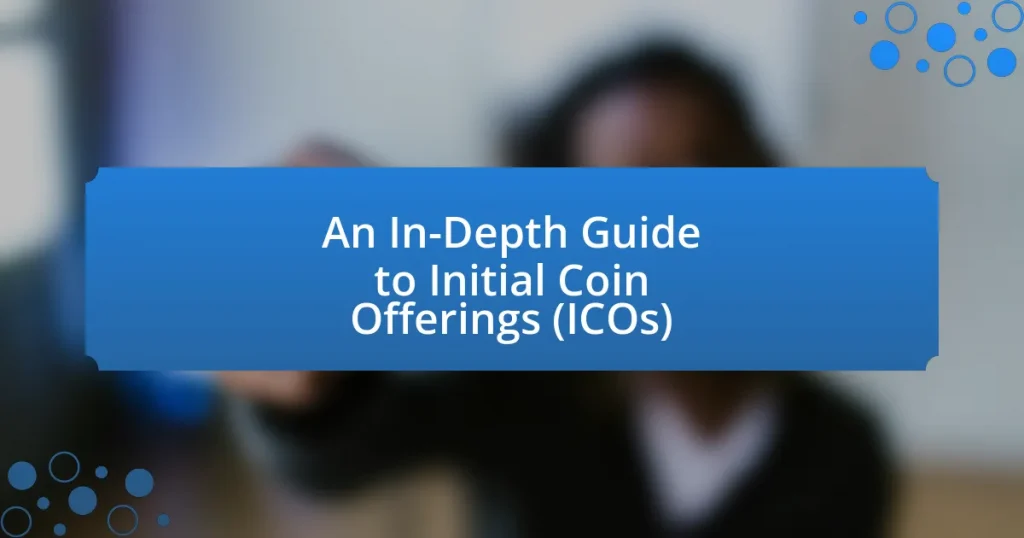Initial Coin Offerings (ICOs) are fundraising mechanisms that enable startups to raise capital by selling new cryptocurrencies or tokens in exchange for established cryptocurrencies like Bitcoin or Ethereum. This article provides a comprehensive overview of ICOs, detailing their differences from traditional fundraising methods, key characteristics, and the components involved in launching an ICO. It also addresses the risks associated with ICO participation, including potential fraud and regulatory uncertainties, while offering insights into best practices for investors. Additionally, the article explores future trends in ICOs, such as increased regulatory scrutiny and the integration of decentralized finance principles, highlighting the evolving landscape of this fundraising approach.
--Initial-Coin-Offerings-(ICOs)-are-fundraising-mechanisms-in--1.webp)
What are Initial Coin Offerings (ICOs)?
Initial Coin Offerings (ICOs) are fundraising mechanisms in which new cryptocurrencies or tokens are sold to investors, typically in exchange for established cryptocurrencies like Bitcoin or Ethereum. ICOs allow startups to raise capital for their projects by offering a portion of their cryptocurrency supply to early backers, often before the project is fully developed. According to a report by CoinDesk, ICOs raised over $4 billion in 2017 alone, highlighting their popularity as an alternative to traditional venture capital funding.
How do ICOs differ from traditional fundraising methods?
ICOs, or Initial Coin Offerings, differ from traditional fundraising methods primarily in their use of blockchain technology and cryptocurrency for raising capital. Unlike traditional fundraising, which often involves equity or debt financing through investors or banks, ICOs allow startups to issue digital tokens directly to the public in exchange for cryptocurrencies like Bitcoin or Ethereum. This method enables broader access to funding, as it can reach a global audience without the regulatory constraints typically associated with traditional fundraising. Additionally, ICOs often provide immediate liquidity for investors, as tokens can be traded on various exchanges shortly after the offering, contrasting with traditional investments that may have longer lock-up periods.
What are the key characteristics of ICOs?
Initial Coin Offerings (ICOs) are characterized by their fundraising mechanism that allows startups to raise capital by issuing tokens in exchange for cryptocurrencies, typically Bitcoin or Ethereum. ICOs often feature a whitepaper that outlines the project’s goals, technology, and tokenomics, providing potential investors with essential information. Additionally, ICOs are generally unregulated, which can lead to high risks for investors, including the potential for fraud. The tokens issued during an ICO can serve various purposes, such as utility tokens for accessing a service or security tokens representing ownership in an asset. The success of an ICO is often measured by the amount of funds raised and the subsequent market performance of the tokens.
Why have ICOs gained popularity in recent years?
ICOs have gained popularity in recent years primarily due to their ability to provide startups with quick access to capital. This fundraising method allows companies to bypass traditional venture capital routes, enabling them to raise funds directly from investors through the sale of tokens. In 2017 alone, ICOs raised over $5.6 billion, showcasing their rapid growth and appeal. The decentralized nature of blockchain technology also attracts investors seeking innovative projects, while the potential for high returns on investment further fuels interest in ICOs.
What are the main components of an ICO?
The main components of an Initial Coin Offering (ICO) include the whitepaper, token distribution, fundraising mechanism, and marketing strategy. The whitepaper outlines the project’s goals, technology, and use cases, providing potential investors with essential information. Token distribution details how tokens will be allocated among investors, team members, and advisors, ensuring transparency. The fundraising mechanism specifies the method of raising capital, such as through Ethereum or Bitcoin, and sets the terms for participation. Lastly, the marketing strategy is crucial for attracting investors and creating awareness about the ICO, often involving social media campaigns and community engagement. These components collectively define the structure and execution of an ICO, influencing its success and investor confidence.
What role do whitepapers play in ICOs?
Whitepapers serve as foundational documents in Initial Coin Offerings (ICOs), outlining the project’s vision, technology, and implementation strategy. They provide potential investors with critical information about the cryptocurrency, including its purpose, the problem it aims to solve, the team behind it, and the tokenomics involved. A well-crafted whitepaper enhances transparency and credibility, which are essential for attracting investment; for instance, the Ethereum whitepaper detailed its smart contract functionality, contributing to its successful ICO in 2014 that raised over $18 million.
How is the token distribution structured in an ICO?
Token distribution in an Initial Coin Offering (ICO) is typically structured to allocate a specific percentage of the total token supply to various stakeholders. Common categories include a portion for investors, a reserve for the project team, funds for marketing, and allocations for future development. For instance, a standard distribution might allocate 50% to investors, 20% to the team, 15% for marketing, and 15% for reserves. This structure ensures that the project has sufficient funding while also incentivizing the team and promoting growth. The exact percentages can vary significantly based on the project’s goals and strategy, but transparency in this distribution is crucial for building trust with potential investors.
What are the risks associated with participating in an ICO?
Participating in an Initial Coin Offering (ICO) carries several risks, including regulatory uncertainty, potential for fraud, and lack of investor protections. Regulatory uncertainty arises because many jurisdictions have not established clear guidelines for ICOs, which can lead to legal repercussions for investors. The potential for fraud is significant, as some ICOs may be scams designed to mislead investors and disappear with their funds. Additionally, the lack of investor protections means that participants may have limited recourse in the event of a failed project or loss of funds. According to a report by the Blockchain Transparency Institute, approximately 80% of ICOs launched in 2017 were deemed scams, highlighting the high risk associated with these investments.
What common scams should investors be aware of?
Investors should be aware of several common scams, including Ponzi schemes, pump-and-dump schemes, and fake Initial Coin Offerings (ICOs). Ponzi schemes promise high returns with little risk, relying on new investors’ funds to pay earlier investors, ultimately collapsing when new investments dry up. Pump-and-dump schemes involve artificially inflating the price of a cryptocurrency through misleading statements, allowing scammers to sell at a profit before the price crashes. Fake ICOs present themselves as legitimate fundraising efforts for new cryptocurrencies but often disappear with investors’ funds. According to the U.S. Securities and Exchange Commission, many ICOs have been found to be fraudulent, highlighting the importance of thorough research and skepticism before investing.
How can investors assess the legitimacy of an ICO?
Investors can assess the legitimacy of an ICO by conducting thorough due diligence, which includes evaluating the project’s whitepaper, team credentials, and community engagement. A well-structured whitepaper should clearly outline the project’s goals, technology, and use case, while the team should consist of experienced professionals with a proven track record in relevant fields. Additionally, active community engagement on platforms like Telegram or Reddit can indicate transparency and investor interest. According to a study by the University of Cambridge, 90% of ICOs fail due to lack of transparency, underscoring the importance of these assessment criteria.
-inv-2.webp)
What is the process of launching an ICO?
The process of launching an Initial Coin Offering (ICO) involves several key steps. First, a project team must develop a clear business plan and whitepaper that outlines the project’s goals, technology, and tokenomics. This document serves as a foundational reference for potential investors. Next, the team needs to create a prototype or minimum viable product (MVP) to demonstrate the project’s feasibility and attract interest.
Following this, the project must ensure compliance with relevant regulations, which may vary by jurisdiction, to avoid legal issues. The team then sets a fundraising goal and determines the token distribution model, including pricing and allocation for investors, team members, and advisors.
Once these elements are in place, the project can initiate marketing efforts to build community engagement and awareness, often utilizing social media, forums, and influencer partnerships. Finally, the ICO is launched, allowing investors to purchase tokens during a specified period, after which the tokens are typically listed on cryptocurrency exchanges for trading. This structured approach is essential for a successful ICO, as evidenced by the significant capital raised in successful offerings, such as Ethereum’s ICO in 2014, which raised over $18 million.
What steps are involved in preparing for an ICO?
Preparing for an Initial Coin Offering (ICO) involves several key steps. First, a project team must define the purpose and goals of the ICO, ensuring that the token has a clear utility within the ecosystem. Next, the team should conduct thorough market research to understand the competitive landscape and target audience. Following this, a whitepaper must be drafted, detailing the project, technology, tokenomics, and roadmap, which serves as a critical document for potential investors.
Subsequently, legal compliance is essential; the team should consult with legal experts to navigate regulations in relevant jurisdictions, ensuring that the ICO adheres to securities laws. After establishing a legal framework, the team should develop a marketing strategy to promote the ICO, which may include building a community through social media, forums, and partnerships.
Finally, the technical infrastructure must be set up, including the smart contract development and security audits to prevent vulnerabilities. Each of these steps is crucial for a successful ICO launch, as they collectively build credibility and trust with potential investors.
How important is market research before launching an ICO?
Market research is crucial before launching an ICO as it helps identify target audiences, assess market demand, and understand competitive landscapes. Conducting thorough market research enables project teams to tailor their offerings to meet investor expectations and mitigate risks associated with market entry. For instance, a study by PwC found that 46% of ICOs failed due to a lack of market understanding, highlighting the necessity of informed decision-making based on research.
What legal considerations must be addressed during an ICO launch?
Legal considerations during an ICO launch include compliance with securities regulations, anti-money laundering (AML) laws, and consumer protection laws. Regulatory bodies, such as the U.S. Securities and Exchange Commission (SEC), classify many tokens as securities, requiring issuers to register or qualify for an exemption. Additionally, adherence to AML regulations mandates that ICOs implement Know Your Customer (KYC) procedures to verify the identities of participants. Failure to comply with these legal frameworks can result in significant penalties, including fines and legal action against the ICO organizers.
How is the success of an ICO measured?
The success of an ICO is measured primarily by the amount of funds raised during the offering. A successful ICO typically achieves its funding goals, which can be quantified in terms of total capital collected, often expressed in fiat currency or cryptocurrency. For instance, the ICO of Ethereum in 2014 raised over $18 million, demonstrating significant investor interest and confidence. Additionally, the post-ICO performance of the token in the market, including its price stability and trading volume, serves as a further indicator of success. A token that maintains or increases its value after the ICO suggests strong market demand and effective project execution.
What metrics are used to evaluate ICO performance?
Metrics used to evaluate ICO performance include funds raised, token distribution, market capitalization, and community engagement. Funds raised indicate the financial success of the ICO, while token distribution assesses how well tokens are allocated among investors. Market capitalization reflects the total value of the tokens in circulation, providing insight into the project’s perceived worth. Community engagement, measured through social media activity and forum discussions, indicates investor interest and support. These metrics collectively help stakeholders gauge the overall effectiveness and potential success of an ICO.
How do post-ICO developments impact token value?
Post-ICO developments significantly impact token value through factors such as project execution, partnerships, and community engagement. Successful implementation of the project’s roadmap can enhance investor confidence, leading to increased demand and higher token prices. For instance, projects that deliver on promised features or secure strategic partnerships often see a positive correlation with their token value. Additionally, active community involvement and transparent communication can foster loyalty and attract new investors, further driving up the token’s market price. Historical examples include Ethereum, which experienced substantial value growth following its ICO due to continuous development and ecosystem expansion.

What are the future trends in ICOs?
Future trends in ICOs include increased regulatory scrutiny, a shift towards security token offerings (STOs), and the integration of decentralized finance (DeFi) principles. Regulatory bodies are focusing on establishing clearer guidelines to protect investors, which may lead to more compliant and transparent ICOs. The rise of STOs, which offer more security and regulatory compliance compared to traditional ICOs, is becoming prominent, as they provide investors with ownership rights and are subject to securities laws. Additionally, the incorporation of DeFi elements into ICOs is expected to enhance liquidity and accessibility, allowing for innovative fundraising mechanisms. These trends are supported by the growing demand for safer investment options and the evolving landscape of blockchain technology.
How are regulations evolving around ICOs?
Regulations around Initial Coin Offerings (ICOs) are evolving to enhance investor protection and ensure compliance with existing financial laws. Governments and regulatory bodies, such as the U.S. Securities and Exchange Commission (SEC), have increasingly classified many ICOs as securities offerings, requiring issuers to register with the SEC or qualify for an exemption. This shift aims to mitigate fraud and provide clearer guidelines for token sales. For instance, in 2021, the SEC emphasized the need for transparency and accountability in ICOs, leading to stricter enforcement actions against non-compliant projects.
What impact will regulatory changes have on future ICOs?
Regulatory changes will significantly impact future ICOs by imposing stricter compliance requirements and enhancing investor protection. As governments worldwide increasingly recognize the need for regulation in the cryptocurrency space, ICOs may face new rules regarding disclosures, anti-money laundering (AML) practices, and securities classifications. For instance, the U.S. Securities and Exchange Commission (SEC) has already classified certain tokens as securities, which requires ICOs to register and comply with federal securities laws. This shift could lead to a reduction in the number of ICOs, as projects may find it more challenging to navigate the regulatory landscape, ultimately resulting in a more secure but less innovative market.
What innovations are emerging in the ICO space?
Emerging innovations in the ICO space include the use of decentralized finance (DeFi) protocols, which enhance liquidity and accessibility for token offerings. Additionally, the integration of non-fungible tokens (NFTs) into ICOs is gaining traction, allowing for unique asset representation and ownership verification. Furthermore, regulatory compliance tools are being developed to ensure that ICOs adhere to legal standards, thereby increasing investor confidence. These innovations are supported by the growing trend of blockchain interoperability, which facilitates cross-chain token offerings, expanding market reach and user engagement.
How are decentralized finance (DeFi) projects influencing ICOs?
Decentralized finance (DeFi) projects are significantly influencing initial coin offerings (ICOs) by shifting investor expectations towards transparency, liquidity, and community governance. DeFi’s emphasis on decentralized protocols and smart contracts has led ICOs to adopt similar frameworks, enhancing trust and reducing reliance on centralized entities. For instance, the rise of decentralized exchanges (DEXs) has provided ICO projects with alternative fundraising avenues, allowing them to bypass traditional exchanges and reach a broader audience. Additionally, the integration of yield farming and staking mechanisms in DeFi has encouraged ICOs to offer more attractive incentives to investors, thereby increasing participation rates. This shift is evidenced by the growing number of ICOs that incorporate DeFi elements, reflecting a trend towards more innovative and community-driven fundraising models.
What best practices should investors follow when participating in an ICO?
Investors should conduct thorough research on the ICO project, including its whitepaper, team credentials, and market potential. This practice ensures that investors understand the project’s goals, technology, and the experience of the team behind it. According to a study by the University of Cambridge, 90% of ICOs fail due to lack of transparency and poor execution, highlighting the importance of due diligence. Additionally, investors should only invest what they can afford to lose, as the volatility in the cryptocurrency market can lead to significant financial loss. Following these best practices can help mitigate risks associated with ICO investments.
How can investors conduct thorough due diligence on ICOs?
Investors can conduct thorough due diligence on ICOs by evaluating the project’s whitepaper, team credentials, and community engagement. The whitepaper should clearly outline the project’s goals, technology, and tokenomics, providing transparency and feasibility. Investors should verify the backgrounds of the founding team and advisors, ensuring they possess relevant experience and a track record in the industry. Additionally, assessing community engagement through social media channels and forums can provide insights into the project’s credibility and investor sentiment. According to a study by CoinDesk, 80% of ICOs fail due to lack of transparency and poor team qualifications, highlighting the importance of these due diligence steps.
What strategies can mitigate risks when investing in ICOs?
To mitigate risks when investing in ICOs, investors should conduct thorough due diligence on the project, including evaluating the team, technology, and market potential. Researching the backgrounds of the founding team can reveal their experience and credibility, while analyzing the whitepaper helps assess the project’s viability and innovation. According to a study by the University of Cambridge, 90% of ICOs fail due to lack of transparency and poor execution, highlighting the importance of scrutinizing these factors. Additionally, diversifying investments across multiple ICOs can reduce exposure to any single project’s failure, further minimizing risk.
It is not possible to provide an answer to the question “
” as it does not contain a specific inquiry or context related to Initial Coin Offerings (ICOs).


